Bulletin – September 2015 Australian Economy Long-run Trends in Housing Price Growth
- Download the article 263KB
Abstract
This article examines the factors driving long-run trends in Australian housing price growth over the past three decades. During the 1980s, housing prices grew broadly in line with general price inflation in the economy. The period from the 1990s until the mid 2000s saw relatively strong housing price growth associated with a significant increase in the debt-to-income ratio of Australian households. Since the mid 2000s, strong population growth has played an increasing role in explaining housing price growth.
Introduction
Housing is the most important asset owned by the majority of Australian households. It is a large component of household wealth and serves a unique, dual role as an investment vehicle and a durable good from which consumption services are derived. With most mortgages and many small business loans secured against residential dwellings in Australia, housing also forms an important part of the collateral backing the financial sector's balance sheet.
Changes in housing prices can affect the behaviour of a number of economic variables. For example, household consumption can be affected via the housing wealth channel; dwelling investment via a Tobin's Q relationship (whereby investment occurs as long as the expected return is above the cost of the investment); and small business investment can be affected by owners of small businesses facing collateral constraints in accessing credit.[1] Changes in dwelling prices also influence financial stability via their influence on the values of both household balance sheets and the assets backing bank balance sheets.
Over the past 30 years, Australian housing prices have increased on average by 7¼ per cent per year, and over the inflation-targeting period by around 7 per cent per year (Graph 1).[2] However, these averages mask three distinct phases:
- During the 1980s, annual housing price inflation was high, at nearly 10 per cent on average, but so too was general price inflation. In real terms, housing price inflation during the 1980s was relatively low, at 1.4 per cent per annum compared with 4.5 per cent during the period from 1990 to the mid 2000s, and 2.5 per cent over the past decade.
- The 1990s until the mid 2000s were marked by quite high housing price inflation, of 7.2 per cent per annum, on average, in nominal terms.
- Annual nominal housing price inflation over the past decade was lower than either of these periods, at a little over 5 per cent on average.
The remainder of this article analyses to what extent the differences in long-run trends can be explained by differences in fundamental drivers of housing price growth.

Drivers of Long-run Housing Price Growth
Framework
A variety of models have been used in the literature to understand what determines housing prices. Much of the literature focuses on whether the observed level of prices is in line with fundamental determinants. In contrast, this article examines the extent to which changes or trends in such fundamental drivers correlate with observed changes in longer-run housing price growth.
The price of any good or asset is determined jointly by demand and supply. In this sense many of the frameworks in the existing literature are only partial because they often focus on either demand- or supply-side factors. One framework that nests a number of approaches and allows joint consideration of the supply and demand side is the stock-flow model of the housing market; it captures the dynamic interaction between housing demand, supply and prices over the time (DiPasquale and Wheaton 1994).
In the stock-flow model, demand for housing assets (from both owner-occupiers and investors) is negatively related to the price and user cost (the cost of owning), and positively related to rent. A number of other variables also play a role, including demographic factors, the permanent income of households, and the cost of and access to credit. This encompasses different models of demand. One is the user cost of housing, which relates the price of owning a home to the cost of renting and has been estimated for Australia by Fox and Tulip (2014). The user cost is dependent on the real interest rate, running costs, depreciation of the asset and the expected real rate of housing price appreciation. Similarly, an investor would consider whether the rental return covers the user cost of owning the property, although the point of ‘no arbitrage’ will be different to that of an owner-occupier, given the different tax treatment of owner-occupied and investor property in Australia. Another, complementary view is that housing is like any other asset, where the price today reflects the sum of expected future discounted cash flows. However, property assets are likely to behave differently to other asset classes because, in comparison with most financial assets, they involve relatively large transaction costs, are traded in relatively thin markets and consist of heterogeneous products (Case and Shiller 1989; Bodman and Crosby 2004).
In the short run, the demand for housing can change more quickly than the supply of housing, and so housing prices will need to adjust temporarily to equilibrate housing demand and supply (unless vacant housing can absorb the change in demand). Supply adjustments in response to demand shocks usually take some time, reflecting both the timing lags associated with the construction of new supply and – in the case of supply reductions – that the existing stock is large relative to the flow of new dwellings (Ellis 2006). A developer will decide to construct a new dwelling if the cost of construction (including the cost of purchasing and readying the land) is less than the expected sale price of the new dwelling, including the land. (This framework is often referred to as the Tobin's Q model.) As new dwellings are built, all other things equal, downward pressure is placed on prices until supply and demand are equilibrated in the long run. The (new) long-run equilibrium price will depend on the relative price elasticities of supply and demand for housing.
Inflation
Measured in nominal terms, growth in housing prices will be affected by the general level of inflation. As already noted, during the 1980s, nominal housing price inflation was relatively high and volatile, but so too was general price inflation. Indeed, until the late 1980s, housing prices grew broadly in line with general price inflation.
Over the past 20 years, general price inflation was low and stable, consistent with the inflation target of 2 to 3 per cent per annum, which was introduced in the early 1990s. Housing price growth, however, has outstripped the rate of inflation in other prices in the economy including inflation in the cost of new dwellings (Graph 2).[3] In real terms, housing price growth since the 1990s was above that of the 1980s. One possible explanation is that this reflects improvements in the quality of housing over time that have not been adequately measured. The housing price measure used in Graph 2 (which is a hedonically adjusted housing price index) already abstracts from the higher costs of a number of quality improvements, such as the increase in floor space and the addition of modern conveniences such as air conditioning, but it may not fully capture all improvements.[4] An alternative benchmark is the value of new dwellings, where changes in quality are explicitly accounted for; this has also increased noticeably over the past few decades. However, housing prices have increased by a considerably faster pace than even the value of new dwellings, which include the costs of quality improvements of housing over time.

This gap between housing prices and different measures of the cost of new housing suggest that, over the past 25 years, factors have been at work that have increased the demand for housing relative to additions in housing supply (including in well-located and more desirable locations) and by more than had been the case during the 1980s.
The remainder of this section reviews some of the drivers that may help to explain relatively stronger demand growth for housing in the past two decades or so: one-off factors such as financial deregulation and the shift in the early 1990s to an environment of low and stable inflation; long-term determinants such as population growth; and cyclical factors that have contributed to housing price growth.
Disinflation, deregulation and housing demand
The deregulation of the financial sector during the 1980s and the shift to a low inflation and low interest rate environment in the early 1990s greatly increased household access to finance in Australia. These developments have been discussed in detail elsewhere (e.g. RBA 2003, 2014; Ellis 2006), so they are only summarised briefly here.
Many important changes to the financial landscape in Australia were made in the mid 1980s up until the early 1990s. Over time, financial deregulation, together with increased competition, increased borrowers' access to credit and reduced its cost. At the same time, the shift from a high- to a low-inflation environment in the 1990s saw nominal interest rates decline in line with the lower inflation compensation required.
Low inflation together with increased competition in the mortgage market reduced housing loan interest rates, thereby easing serviceability constraints. Previously credit constrained households were increasingly able to borrow more for a given level of income and pay higher prices. Without a corresponding increase in supply in the most desirable locations, this was likely to have led to a pick-up in housing price growth, and household debt, for a protracted period (Kulish et al 2012).
The increased access to credit by Australian households over this period can be seen in the steady increase of the ratio of household debt to income (Graph 3). A similar trend is observed in the dwelling price-to-income ratio.[5] While deregulation and disinflation were largely complete by the mid 1990s, the adjustment of the economy to the new steady state took well over a decade (Ellis 2005; Kent, Ossolinski and Willard 2007). These adjustments appear to have largely run their course, with the household debt-to-income ratio fluctuating around 150 per cent over the past decade.
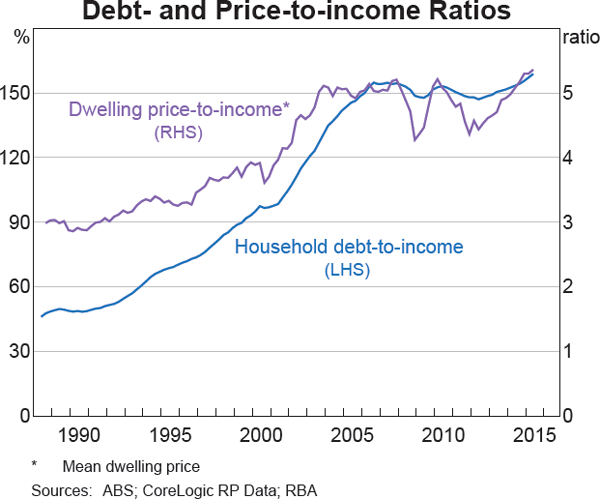
Underlying demand and supply of new housing
Underlying demand for new housing
Underlying demand for new dwellings can be thought of as representing what demand for newly built housing might have been, given the observed rate of population growth and an estimate of underlying average household size (Richards 2009a, 2009b). In other words, this is the longer-run level of demand, abstracting from shorter-term influences on housing demand related to the business cycle. Underlying demand, though unobservable, consists of three components: demand from newly formed households; demand for new dwellings to replace demolished ones; and demand for second or vacant homes (Graph 4). The latter two components have been relatively stable contributors to underlying demand compared with changes in the household formation rate, which have driven most of the variation in estimates of underlying demand. The rate of household formation in turn reflects the interaction between population growth and average household size.[6]
From 1990 to the mid 2000s, population growth in Australia was relatively low compared with that of the previous two decades, owing to a declining natural rate of population growth and lower net immigration. Since the mid 2000s, Australia has seen much higher net immigration and so population growth has stepped up to a significantly higher rate (Graph 5). A slightly higher natural increase in population has also contributed to the shift.
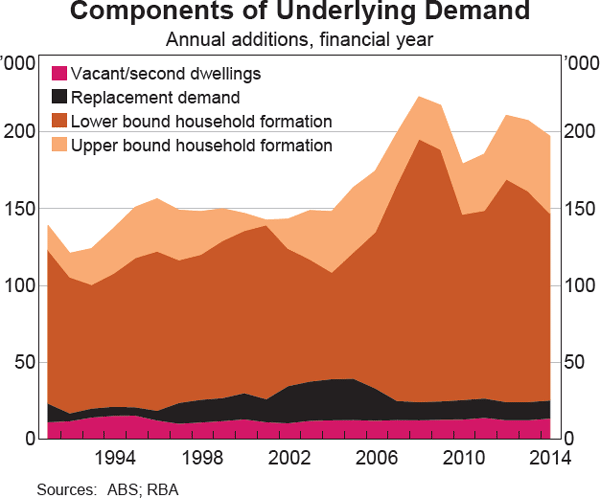
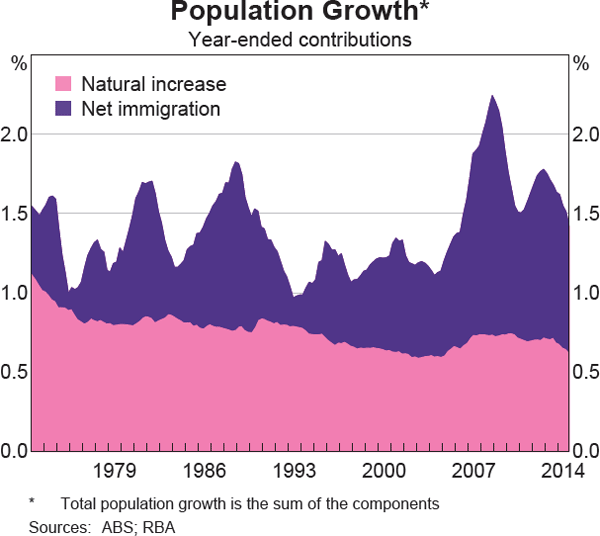
Average household size – the other component of the household formation rate – has declined markedly since the 1960s and, all else equal, has generated an increase in demand for housing for a given level of population (Graph 6). Unlike the earlier trend, average household size has been little changed since the 2000s. Changes in average household size reflect a combination of demographic changes, household preferences and endogenous responses to housing prices (Richards 2009a, Richards 2009b). Much of the downward trend over the past five decades has been attributed to demographic changes resulting from falling fertility rates, an ageing population and rising household incomes (Kearns 2012).[7] These forces have resulted in smaller-sized households, on average, that have demanded more housing for a given level of population (Ellis 2010). Average household size may also adjust in response to changes in housing prices. To the extent that pressures arising from higher demand for new housing outstrip supply increases over a short period, some of the excess demand is likely to be accommodated by short-term increases in average household size.

Combining the range of estimates of average household size, population growth and demand for second homes and replacement dwellings, suggests that annual demand for new housing was relatively stable prior to the mid 2000s, fluctuating between 120,000 and 145,000 new dwellings every year (Graph 4). Since then, annual demand for new housing increased by around 40 per cent (or by around 50,000 new dwellings), largely owing to strong population growth.
Will underlying demand remain elevated? Forecasts from the Department of Immigration and Border Protection suggest that population growth has declined noticeably over the past year or so, but population is still expected to expand at a pace above that recorded from 1990 to the mid 2000s. Underlying demand for new dwellings will also depend on developments in average household size. To the extent that the levelling off in household size since the early 2000s has partly reflected a response to rising housing prices, average household size could rise, thereby offsetting any increase in demand from population growth.
Supply of new housing
Whether or not an increase in demand leads to increased housing price growth depends on the response of supply to changes in demand. There is considerable evidence that, in the short run, there are lags in the ability of the supply of housing to respond to changes in demand. This is not surprising given the length and complexity of the planning process, the time taken to construct new dwellings, the difficulty in the provision and funding of required infrastructure, as well as the cost of readying undeveloped land for construction and availability of suitable sites (Hsieh, Norman and Orsmond 2012). Previous Australian and international literature has pointed out that local zoning and planning policies have played a prominent role in explaining some of the protracted supply-side rigidities observed in many housing markets (Glaeser, Gyourko and Saks 2005; Kulish et al 2012). If supply additions fall short of underlying demand for new housing for a time, prices can be expected to increase, at least until additional supply is available. Moreover, given the lags associated with construction, expected price changes play an important role in developers' decision-making processes.
Over the past three decades, dwelling completions have been relatively stable, at around 130,000 to 145,000 completions per annum (Graph 7). However, completions alone hide the noticeable increase in size and improvement in the quality of new dwellings that have occurred over time, along with the increased cost associated with their construction (Kearns 2012). For example, the average number of spare bedrooms has increased over the past 20 years for households across all age groups and most household types.[8]
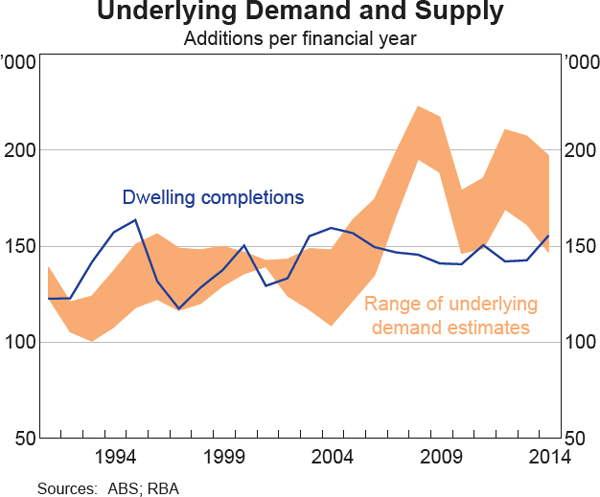
Annual supply and demand gap
When compared with the range of underlying demand estimates, completions suggest that, over much of the past decade, the supply side has been slow, or unable, to respond to the significant increases in underlying demand (based on estimates of underlying average household size, rather than actual household size).[9] More recently, the gap between underlying demand for and supply of new dwellings in Australia looks to have become smaller (Graph 7). Graph 8 suggests that much of the aggregate gap was accounted for by developments in New South Wales. Underlying demand-supply gaps in Queensland and Western Australia also look to have contributed to the aggregate gap, although the estimates of underlying demand on a state level are subject to even larger uncertainty than those at the national level (since some of the assumptions made on household formation are less likely to hold at a disaggregated level). More recently, new supply in New South Wales has increased sharply, consistent with the earlier period of strong underlying demand growth and the significant time lags in building construction, as well as very low interest rates currently that could be expected to underpin developers' expectations for housing price growth to continue for some time. It could also be that an increased policy focus in recent years on alleviating supply-side rigidities has played some role in facilitating this pick-up (see also Hsieh et al (2012)).
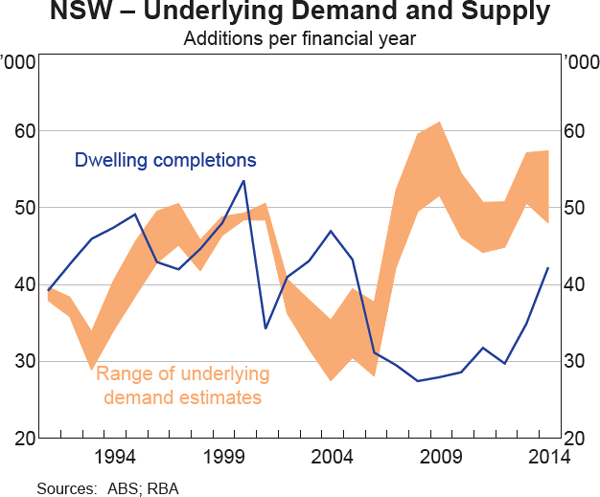
To summarise, since the mid 2000s, the Australian housing market looks to have been subject to a series of persistent increases in demand stemming from high population growth, while supply has continued to increase by around 145,000 dwellings. Graph 9 suggests that the excess demand for new dwellings (measured as underlying additional demand less additional dwellings) may have played a role in generating price growth since the mid 2000s, while it looks to have played a less prominent role in the decade before that.
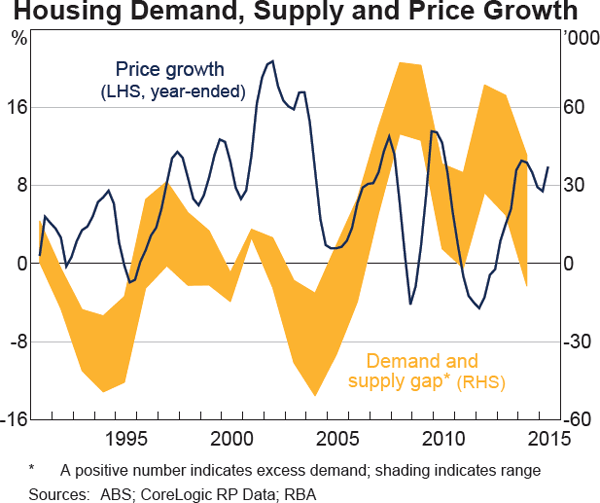
Cyclical factors
While this article focuses on longer-run drivers of housing price growth, cyclical factors are likely to play a role in driving price growth over shorter periods. Most notably, monetary policy is thought to have an especially strong effect on the housing market, both in the established market through higher activity and prices and in the new dwelling market by encouraging dwelling investment. In fact, Otto (2007) finds that the level of the mortgage interest rate was a significant explanator of Australian capital city dwelling price growth over a period of around 20 years. While a lower mortgage rate encourages consumption of housing to be brought forward, in the long run, even if mortgage rates were to remain low for an extended period of time, there should be a supply response to help move the market back into its longer-run equilibrium. Indeed, the reduction in real mortgage rates since 2011 – following reductions in the cash rate – has been closely associated with both stronger housing price growth and strong dwelling construction more recently.
An Illustrative Example
The analysis in the previous section suggests a number of factors that are likely to have been associated with the longer-term trends in housing price growth over the inflation targeting period: the move to an environment of low inflation and easier access to credit following financial deregulation, as well as differences between the underlying demand for new dwellings and their supply. In order to illustrate the importance of these factors both over time and relative to each other, the exercise in this section is based on a very simple estimated model of housing price growth since 1991, motivated by Otto (2007).
The model, discussed in more detail in Appendix A, considers the relationship between annual housing price growth and changes in the debt-to-income ratio as well as changes in the gap between the underlying demand and the supply in the preceding year. While this simple model cannot account for all the factors affecting housing price growth over the past 25 years, the model is able to account for more than half of the variation. As it is difficult to disentangle the causality between housing price growth and changes in the debt-to-income ratio, the results are only indicative and do not necessarily imply causation.[10] However, if households' ability or willingness to borrow (relative to their income) is a binding constraint in their housing purchase decision, then an increase in the debt-to-income ratio should lead to higher house prices, all else equal.
Graph 10 (based on this illustrative model) suggests that housing price growth was closely associated with changes in the debt-to-income ratio over most of the 1990s until the mid 2000s (the exception is the period around 2000/01, where housing market activity was affected by the introduction of the GST (Kearns and Lowe 2011)). The underlying demand gap has played a more prominent role over the past decade, and changes in the debt-to-income ratio played a less prominent role over this period.

Other empirical studies suggest that real income growth is one of the main drivers of housing price growth over very long periods. If we include changes in real income per capita or real income in our econometric model, the coefficient is insignificant, suggesting that over the sample period considered here higher income per capita has had no role to play above its effect on underlying average household size.
Interest rate cycles do not appear to have had a particular correlation with housing price growth over and above what is already captured by the debt-to-income ratio and the demand-supply gap. While this contrasts with Otto (2007), that model does not include changes in the debt-to-income ratio. Intuitively, as most property purchase involves borrowing, it seems plausible that changes in the debt-to-income ratio would capture a large share of the impact of changes in interest rates on housing price growth.
Conclusion
This article analyses the factors influencing long-run housing price growth in Australia. During the 1980s, housing price inflation broadly followed general price inflation in the economy, which was relatively high and volatile. Following the financial deregulation of the mid 1980s and disinflation of the early 1990s, cheaper and easier access to finance underpinned a secular increase in households' debt-to-income ratio that was closely associated with high housing price inflation from the early 1990s until the mid 2000s. The past decade saw a stabilisation of debt-to-income levels, but also a prolonged period of strong population growth – underpinned by high immigration – and smaller household sizes that led to increases in underlying demand exceeding the supply of new dwellings.
Looking ahead, it seems unlikely that there will be a return to the rather extreme conditions of the earlier episode when significant increases in household debt supported high housing price growth. Nonetheless, protracted periods of changes in population growth that are not met by adjustments in dwelling supply could lead to periods of sizeable changes in housing price growth. One important factor for housing price growth is the ability of the supply of new dwellings to respond to changes in demand. The significance of this is made clear by the recent increases in higher-density housing and lower growth of those prices relative to prices of detached houses, whose supply has been less responsive.
Appendix A
The econometric model of housing price growth discussed here was chosen to evaluate the validity and relative importance of the key factors identified. The purpose is not, however, to identify the best empirical model for housing price growth and a different model might be preferable for that purpose.
Equation (1) shows the specification underlying the illustrative example used in the text (Graph 10) for annual growth in Australian capital city housing prices, estimated over 1991 to 2014 (standard errors are shown in parentheses).[11]
ΔlnPt is the annual rate of growth in nominal housing prices (in per cent), ΔDebt_Incomet is the change in the household debt-to-income ratio from t − 1 to t, and Gapt−1 is the difference between underlying supply and demand (using the middle of the estimated data range) from the previous year, divided by 1,000. Nominal inflation, which has been relatively stable over the estimation period, is captured as part of the constant. The model has quite high explanatory power, with an adjusted R2 of 0.55, and has no serial correlation of note. Note that the introduction of the GST in 2000/01 is not well captured in the model.[12]
In the model, the contemporaneous change in the debt-to-income ratio is significant, which could have a number of explanations. First, the time structure of dwelling purchases is such that, even though households often have pre-approval of finance when they purchase a dwelling, they usually take out a loan only after they purchase; the measured relationship is therefore close to contemporaneous, even though the decision might be causal from debt-to-income ratio to housing price. Second, there is a feedback between housing debt and house prices: an increase in the availability of finance allows households to pay higher housing prices, but higher housing prices in turn also require higher borrowing. The possible reverse causality means that the relationship between housing price growth and changes in debt-to-income ratios is not necessarily a causal relationship (in a temporal sense), but rather represents a correlation.
An instrumental variable (IV) estimate could, in principle, account for a possible endogeneity bias in the coefficient of the change in the debt-to-income ratio. However, this approach proved not to be possible in the model presented here for two reasons. First, our data covers only 23 years, which would make any IV estimates vulnerable to small sample bias. Using a longer time series (that is, including data prior to the 1990s) poses the problem of a number of structural changes in the economic relationships discussed in this article. Second, it is difficult to find a suitable instrument for the effect of financial deregulation and disinflation on households' indebtedness. The real mortgage rate facing household borrowers is one potential instrument. However, the measured changes in the real mortgage rate happened relatively quickly compared with the time it took for households to change their debt and house purchase decisions in response. As Bayoumi (1993) and Kent et al (2007) emphasise, the change to household behaviour can easily take more than a decade, including because of the relatively low frequency with which an individual household purchases a new home. As a result, it is difficult to find a good instrument for these changes in households' debt relative to their income, which would allow to better control for the possible endogeneity between house prices and the debt-to-income ratio. However, if households' ability or willingness to borrow (relative to their income) is a binding constraint in their housing purchase decision, then an increase in the debt-to-income ratio should lead to higher house prices. In this case, the endogeneity bias (of higher house prices in turn leading to a higher debt-to-income ratio in the same time period) is likely to be relatively minor.
Footnotes
Marion Kohler is from International Department but completed this work in Economic Analysis Department, and Michelle van der Merwe is from Economic Analysis Department. The authors would like to thank Luci Ellis, Tony Richards, Peter Tulip and, in particular, James Hansen for valuable comments and discussions. [*]
More detail can be found in Dvornak and Kohler (2003) and Windsor, Jääskelä and Finlay (2013) on the wealth channel; Corder and Roberts (2008) on dwelling investment and Tobin's Q; and Connolly, La Cava and Read (2015) on the housing collateral channel. [1]
For a discussion of very long-term developments in housing prices over the past century, see Stapledon (2012). [2]
This is true for both the CPI measure for new dwelling cost inflation in Graph 2 and the building cost index published by Rawlinsons (2014), which follows the CPI closely over that period. [3]
Most notably, the hedonic measure of housing prices used in Graph 2 may not abstract fully from a premium that is being placed on living close to the city centre (or other desirable locations) as cities increase in size over time (Ellis and Andrews 2001; Kulish, Richards and Gillitzer 2012) or the shift to higher-quality building materials used in construction (Kearns 2012). [4]
The reduction in the rate of inflation also contributed to the trend increase in the debt-to-income ratio; the rate at which nominal income growth will erode debt occurs less rapidly than in a high inflation environment (RBA 2003). Also, it is possible that households are willing to spend relatively more on housing as their real incomes rise, and this could also contribute to a rising debt-to-income ratio. However, the flattening out of the debt-to-income ratio over the past decade (when real incomes have continued to increase) suggests that this may have been a less important factor over the time period considered here. [5]
Data on average household size are only available in Census years and average household size measured at any point consists of a longer-run underlying trend (determined by demographics, income etc.), and shorter-term adjustments in response to changes in housing prices (see below). In order to extract the longer-run, underlying trend of average household size, three alternative trend measures are fitted to generate annual estimates. The result is a range of scenarios for underlying demand, helping to account for some of the uncertainty around its estimation. [6]
Migration flows can also be a source of demographic change in average household size in countries with significant immigration such as Australia, if migrant household sizes are different to those of the existing population. [7]
Thanks to Mark Caputo and Stephen Knop for providing this analysis. [8]
See footnote 6 for details on the estimates of underlying average household size. [9]
For more details, see Appendix A. [10]
The lag specification was determined through general-to-specific modelling, starting with a model with a sufficiently long lag structure of all exogenous variables and removing insignificant variables step by step. [11]
If a dummy variable is included in 2000/01 for the introduction of the GST the adjusted R2 becomes 0.70 and the coefficient estimates are broadly similar. [12]
References
Bayoumi T (1993), ‘Financial Deregulation and Household Saving’, Economic Journal, 103(421), pp 1432–1443.
Bodman P and M Crosby (2004), ‘Can Macroeconomic Factors Explain High House Prices in Australia’, Australian Property Journal, 38(3), pp 175–179.
Case K and R Shiller (1989), ‘The Efficiency of the Market for Single-Family Homes’, The American Economic Review, 79(1), pp 125–137.
Connolly E, G La Cava and M Read (2015), ‘Housing Prices and Entrepreneurship: Evidence for the Housing Collateral Channel in Australia (Draft paper)’, RBA Small Business Conditions and Finance Conference, March.
Corder M and N Roberts (2008), ‘Understanding Dwellings Investment’, Bank of England Quarterly Bulletin, December, pp 393–403.
DiPasquale D and W Wheaton (1994), ‘Housing Market Dynamics and the Future of Housing Prices’, Journal of Urban Economics, 35(1), pp 1–27.
Dvornak N and M Kohler (2003), ‘Housing Wealth, Stock Market Wealth and Consumption: A Panel Analysis for Australia’, RBA Research Discussion Paper No 2003–07.
Ellis L (2005), ‘Disinflation and the Dynamics of Mortgage Debt’, in Investigating the Relationships between the Financial and Real Economy, BIS Papers No 22, BIS, Basel, pp5–20.
Ellis L (2006), ‘Housing and Housing Finance: The View from Australia and Beyond’, RBA Research Discussion Paper No 2006–12.
Ellis L (2010), ‘Recent Developments in the Housing Market and its Financing’, Address to Financial Review Residential Property Conference 2010, Sydney, 18 May.
Ellis L and D Andrews (2001), ‘City Sizes, Housing Costs, and Wealth’, RBA Research Discussion Paper No 2001-08.
Fox R and P Tulip (2014), ‘Is Housing Overvalued?’, RBA Research Discussion Paper No 2014–06.
Glaeser EL, J Gyourko and R Saks (2005), ‘Why Have Housing Prices Gone Up?’, American Economic Review, 95(2), pp 329–333.
Hsieh W, D Norman and D Orsmond (2012), ‘Supply-Side Issues in the Housing Sector’, RBA Bulletin, September, pp 11–19.
Kearns J (2012), ‘The Outlook for Dwelling Investment’, Address to the Australian Business Economists' Lunchtime Briefing, Sydney, 13 November.
Kearns J and P Lowe (2011), ‘Australia's Prosperous 2000s: Housing and the Mining Boom’, in H Gerard and J Kearns (eds), The Australian Economy in the 2000s, Proceedings of a Conference, Reserve Bank of Australia, Sydney pp 73–100.
Kent C, C Ossolinski and L Willard (2007), ‘The Rise of Household Indebtedness’, in C Kent and J Lawson (eds), The Structure and Resilience of the Financial System, Proceedings of a Conference, Reserve Bank of Australia, Sydney pp 123–163.
Kulish M, A Richards and C Gillitzer (2012), ‘Urban Structure and Housing Prices: Some Evidence From Australian Cities’, Economic Record, 88(282), pp 303–322.
Otto G (2007), ‘The Growth of House Prices in Australian Capital Cities: What Do Economic Fundamentals Explain?’, The Australian Economic Review, 40(3), pp 225–238.
Rawlinsons (2014), Australian Construction Handbook, 32nd edn, Rawlinsons Publishing, Perth.
RBA (2014), Submission to the Financial System Inquiry, Reserve Bank of Australia, Sydney, April.
RBA (2003), ‘Household Debt: What the Data Show’, RBA Bulletin, March, pp 1–11.
Richards T (2009a), ‘Conditions and Prospects in the Housing Sector’, Address to the 4th Annual Housing Congress, Sydney, 26 March.
Richards T (2009b), ‘Housing Market Developments’, Talk to CEDA Housing Forum: A National Round-up, Sydney, 29 September.
Stapledon N (2012), ‘Trends and Cycles in Sydney and Melbourne House Prices from 1880 to 2011’, Australian Economic History Review, 52(3), pp 293–317.
Windsor C, J Jääskelä and R Finlay (2013), ‘Home Prices and Household Spending’, RBA Research Discussion Paper No 2013–04.
